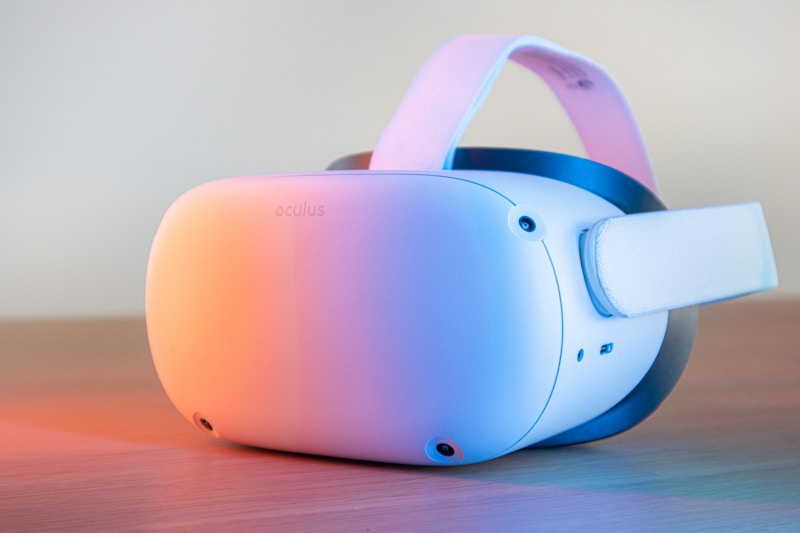The wait for Valve’s next-generation VR headset might finally be over. Brad Lynch, the reliable hardware leaker known as SadlyItsBradley, dropped major news on October 29, 2025 when he discovered that Valve’s Deckard VR headset has progressed to DV1 and DV2 development stages in the latest SteamVR beta. For those unfamiliar with Valve’s internal hardware naming, DV units represent the final stages before the production version that consumers actually buy hits store shelves.
What DV Stages Mean for Release
When hardware reaches DV status at Valve, it means the company has finalized the design and is preparing manufacturing for consumer units. Both the Valve Index and Steam Deck went through just two DV stages before launching to the public. The appearance of both Deckard DV1 and DV2 in SteamVR code suggests Valve is either testing two separate models or simply iterating on a single design before settling on the final production version.
Lynch’s discovery came from digging through SteamVR beta files released on October 9, 2025. The code clearly references these development models by name, confirming that internal testing has reached advanced stages. Combined with reports from Chinese supply chain sources claiming the headset entered mass production in October with target volumes of 400,000 to 600,000 units for the first year, all signs point toward an imminent announcement.
Timeline of Recent Leaks
- February 2025 – Leaker claims $1,200 price tag with Q4 2025 release target
- April 2025 – Shipping manifests reveal Valve importing HMD manufacturing equipment to US facilities
- September 2025 – Valve trademarks Steam Frame name and rebrands SteamVR Overlays to Frames
- October 8, 2025 – Chinese analysts report headset entering mass production
- October 9, 2025 – DV1 and DV2 models appear in SteamVR beta code
- October 28, 2025 – New icon files discovered for Steam Controller 2 and VR controllers
Steam Frame Brand Identity
Valve appears to be ditching the Deckard codename in favor of Steam Frame for the commercial release. The company filed a trademark for Steam Frame back in September 2025 and simultaneously renamed SteamVR Overlays to Frames throughout the software ecosystem. According to Lynch’s analysis, the Frame naming refers to the headset’s all-in-one capabilities and its ability to access games, features, and settings without requiring a PC connection.
This branding shift makes sense from a marketing perspective. Steam Frame ties the headset directly to Valve’s Steam platform while emphasizing its standalone nature. The Meta Quest line proved that consumers want untethered VR experiences, and Valve is clearly positioning this headset as a direct competitor to Meta’s dominance in the standalone VR market.
Hybrid Design Philosophy
What separates Steam Frame from competitors is its hybrid approach. The headset functions as a fully capable standalone device running SteamOS, but it can also wirelessly stream high-end PC VR games through a dedicated Steam Link VR USB dongle. This dongle uses WiFi 6E to maintain consistent low-latency connections for demanding PCVR titles, eliminating the router middleman that causes compression and latency issues with other wireless streaming solutions.
The ARM-based processor inside Steam Frame will run native games through emulation layers similar to how Apple’s Rosetta 2 translates x86 applications for M-series chips. This means players can take the headset anywhere and play titles like Half-Life: Alyx completely standalone without lugging around a gaming PC. When you get home, plug in the wireless dongle and stream your entire PCVR library at maximum fidelity.
| Feature | Steam Frame | Meta Quest 3 | Valve Index |
|---|---|---|---|
| Standalone Mode | Yes with SteamOS | Yes | No |
| PCVR Support | Wireless via WiFi 6E dongle | Wired or compressed wireless | Wired only |
| Expected Price | $1,000-1,200 | $499 | $999 |
| Tracking Method | Inside-out cameras | Inside-out cameras | External base stations |
Roy Controllers Break the Mold
The controllers designed for Steam Frame represent a radical departure from standard VR controller layouts. Codenamed Roy, these controllers feature a full gamepad’s worth of buttons including a D-pad, ABXY face buttons, bumpers, triggers, grip buttons, analog sticks, and system buttons. Instead of splitting buttons between both hands like most VR controllers, Valve placed all face buttons on the right controller and the D-pad on the left.
This layout serves a dual purpose. Players get traditional VR motion controls for immersive games, but they can also use Roy controllers as a standard gamepad for playing flat Steam games on virtual screens. Unlike Meta’s clunky Xbox cloud streaming partnership, Valve wants players to run their entire Steam library locally on the headset. Any game installed on your PC can stream directly to Steam Frame without internet requirements or cloud service subscriptions.
Lynch revealed that every button on Roy controllers features capacitive touch sensors to aid in hand skeleton creation for more realistic hand presence in VR. The controllers also reportedly lack the tracking rings seen on Meta Quest controllers, suggesting Valve has developed advanced camera-based tracking that doesn’t require visible reference points.
Technical Specifications Leaked
While Valve hasn’t officially confirmed specifications, multiple leaks have painted a fairly consistent picture of Steam Frame’s capabilities. The headset features dual displays with at least 1440p resolution per eye running at 120Hz refresh rates, with the hardware potentially supporting experimental 144Hz modes like the Valve Index offered.
Pancake or aspheric lenses will deliver sharper images with less chromatic aberration and distortion compared to the Fresnel lenses used in older headsets. Eye tracking enables dynamic foveated rendering, allowing the headset to render full resolution only where you’re looking while reducing quality in peripheral vision. This dramatically improves performance on the ARM processor for standalone gaming.
High-resolution passthrough cameras enable mixed reality features, letting you see the real world through the headset for safety or AR applications. Audio follows Valve’s open-ear design philosophy established with the Index and Steam Deck, using speakers positioned near but not touching your ears for comfortable extended sessions.
Manufacturing and Release Timeline
Chinese research group XR Research Institute leaked information claiming Valve has entered mass production in October 2025 with ambitious targets between 400,000 and 600,000 units for the first year. A now-deleted WeChat post from user BlackHairSheriff008 stated Valve aims for a Q4 2025 launch to capitalize on the holiday shopping season, though this timeline seems increasingly unlikely given we’re already in late October with no official announcement.
The post initially claimed manufacturing was happening in Shandong, China, but was taken down after revelations it might actually be a Taiwan-based operation. Lynch’s earlier investigations discovered shipping manifests showing Valve importing HMD manufacturing equipment to US facilities in April 2025, suggesting at least some production capacity exists domestically.
More realistic predictions now point toward early 2026 for the actual launch. Valve historically takes its time with hardware releases and rarely rushes products to market before they’re truly ready. The Steam Deck faced multiple delays before finally shipping, and the company would rather launch Steam Frame properly than force it out for arbitrary holiday deadlines.
Pricing Remains Question Mark
Early leaks pegged Steam Frame at $1,200 for the full bundle including the headset, Roy controllers, and wireless PCVR dongle. This premium positioning raised eyebrows among analysts who questioned whether Valve could move 400,000-600,000 units annually at that price point. For comparison, the Meta Quest 3 starts at $499 and the PlayStation VR2 launched at $549.
Industry observers increasingly believe Valve needs to hit sub-$1,000 pricing to achieve their ambitious volume targets. The sweet spot likely sits around $899-999, making Steam Frame more expensive than Meta’s offerings but cheaper than competitors like Apple Vision Pro’s absurd $3,499 entry point. At $999, Steam Frame would match the original Valve Index launch price while offering significantly more functionality.
The bundle may include several pack-in games or demos to justify the premium pricing. Leaks suggest Valve has completed in-house titles specifically for Steam Frame launch, though Half-Life 3 won’t be among them according to insider Tyler McVicker. That doesn’t rule out other Half-Life universe content or brand new IPs designed to showcase the hardware’s capabilities.
Competition in VR Market
Valve enters a VR market that looks dramatically different than when the Index launched in 2019. Meta dominates the standalone segment with Quest 2 and Quest 3 selling millions of units. PlayStation VR2 targets console gamers with high-end features but remains tethered to PS5. Apple Vision Pro redefined mixed reality but at prices only wealthy early adopters can afford.
Steam Frame occupies a unique position straddling the standalone and PCVR markets. Casual users can enjoy standalone gaming without PC investment, while enthusiasts get wireless PCVR streaming that rivals or exceeds wired headset quality. This flexibility could attract customers from both camps who previously had to choose between convenience and performance.
The biggest threat comes from Samsung and Google’s upcoming Android XR platform, which promises to unify smartphone ecosystems with VR and AR devices. If Android XR delivers on its potential, Samsung’s rumored Moohan headset could offer similar hybrid functionality backed by Android’s massive app ecosystem. Valve needs to leverage Steam’s gaming library and PC compatibility advantages to differentiate Steam Frame from whatever Android XR devices eventually launch.
FAQs
When did SadlyItsBradley leak the Steam Frame development stages?
Brad Lynch discovered the DV1 and DV2 development models in SteamVR beta code on October 9, 2025, indicating the headset has reached final development stages before production.
What does DV mean for Valve hardware?
DV stands for Development Version and represents the final testing stages before the production version that consumers buy. Both Valve Index and Steam Deck only went through two DV stages before launch.
When will Valve Steam Frame be released?
While early leaks suggested Q4 2025, most analysts now expect an early 2026 launch given mass production reportedly started in October 2025. Valve hasn’t officially announced a release date.
How much will Steam Frame cost?
Leaked pricing suggests $1,200 for the full bundle, though analysts believe Valve needs to price it under $1,000 to hit their reported 400,000-600,000 unit annual sales targets.
Is Steam Frame standalone or does it need a PC?
Steam Frame functions as both a standalone VR headset running SteamOS and a wireless PCVR headset via a dedicated WiFi 6E USB dongle for streaming games from a gaming PC.
What are the Roy controllers?
Roy is the codename for Steam Frame’s VR controllers, which feature a full gamepad layout including D-pad, ABXY buttons, analog sticks, bumpers, triggers, and grip buttons for playing both VR games and traditional Steam games.
Can Steam Frame play Half-Life: Alyx standalone?
According to leaks, Steam Frame’s ARM processor will be powerful enough to run Half-Life: Alyx natively without requiring a gaming PC, making it the first standalone headset capable of this feat.
Conclusion
SadlyItsBradley’s discovery of DV1 and DV2 models in SteamVR code represents the strongest evidence yet that Valve’s Steam Frame VR headset is nearly ready for public release. After years of rumors, leaked specs, and supply chain reports, all the pieces are finally falling into place for an early 2026 launch. The hybrid design combining standalone functionality with high-end wireless PCVR streaming positions Steam Frame as a potentially game-changing product that could finally deliver on the promise of truly versatile VR hardware. With mass production underway, trademark filings complete, and software integration progressing through beta channels, the only question remaining is when Valve will officially announce what the VR community has been anticipating for over three years. Whether Steam Frame can justify premium pricing in a market dominated by affordable Meta Quest headsets depends entirely on execution, but if any company has earned the benefit of the doubt in VR hardware, it’s Valve.


